What's New Under The Sun
Madison Historic Dial Returns
Monday, 13 October 2025 22:49
 On October 4, 2025 Madison Historical Society of Ohio was able to have their sundial returned after 32 years, when in 1993 it was moved to the lawn of Lake County Courthouse to reduce the chance of vandalism. The sundial was originally placed at Madison Home 100 years ago on Saturday, October 24, 1925 during a conference of the Women's Relief Society. From 1904 to 1962 the state ran this...
On October 4, 2025 Madison Historical Society of Ohio was able to have their sundial returned after 32 years, when in 1993 it was moved to the lawn of Lake County Courthouse to reduce the chance of vandalism. The sundial was originally placed at Madison Home 100 years ago on Saturday, October 24, 1925 during a conference of the Women's Relief Society. From 1904 to 1962 the state ran this...
Elements of Dialing Course - 2025
Monday, 15 September 2025 19:42
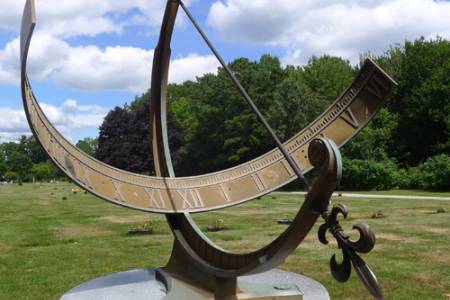 NASS is pleased to announce the upcoming fifth instance of Elements of Dialing, our introductory course about sundials, their history, and the science that makes them work. The free 12-lesson course, intended for those are new to sundialing, runs from 27 October 2025 until 26 April 2026. The course instructor is Robert Kellogg, NASS Vice President and Sundial Registrar. Bob will be...
NASS is pleased to announce the upcoming fifth instance of Elements of Dialing, our introductory course about sundials, their history, and the science that makes them work. The free 12-lesson course, intended for those are new to sundialing, runs from 27 October 2025 until 26 April 2026. The course instructor is Robert Kellogg, NASS Vice President and Sundial Registrar. Bob will be...
Sun Queen of World War II
Thursday, 11 September 2025 23:11
 A Hungarian born American scientist, Mária Telkes (1900-1995), was called "The Sun Queen" and among other honors, was postmousthly inducted into the National Inventors Hall of Fame. She lived to 95 and for most of her life developed solar power in a variety of forms.
Trained as a biophysicist, she worked for Westinghouse Electrical and Manufacturing Company in Pittsburgh, PA, where she...
A Hungarian born American scientist, Mária Telkes (1900-1995), was called "The Sun Queen" and among other honors, was postmousthly inducted into the National Inventors Hall of Fame. She lived to 95 and for most of her life developed solar power in a variety of forms.
Trained as a biophysicist, she worked for Westinghouse Electrical and Manufacturing Company in Pittsburgh, PA, where she...
2025 Conference -Ottawa
Thursday, 28 August 2025 23:25
 The annual NASS Conference was held 7-10 August, 2025 in Ottawa. As usual, the conference began late Thursday afternoon with an introduction social and a "grab bag give away", taking your chances with tickets to win the bag's prize. Will Grant was the final winner of the Walton Double Planar Polar Sundial, but Paul Ulbrich beat the statistic odds and won this prize three times,...
The annual NASS Conference was held 7-10 August, 2025 in Ottawa. As usual, the conference began late Thursday afternoon with an introduction social and a "grab bag give away", taking your chances with tickets to win the bag's prize. Will Grant was the final winner of the Walton Double Planar Polar Sundial, but Paul Ulbrich beat the statistic odds and won this prize three times,...
Prosciutto di Portici Sundial's Owner
Tuesday, 10 June 2025 18:51
 Prosciutto di Portici (Ham) Sundial
Photo: Getty Images
The Prosciutto di Portici Sundial, more often called the Portici Ham Sundial, dates from the first century somewhere between 8 BCE to 79 CE. This small silvered bronze dial was uncovered on 11 June, 1755 in the ruins of Herculaneum (current day Portici) in the "Villa of the Papyri", buried in...
Prosciutto di Portici (Ham) Sundial
Photo: Getty Images
The Prosciutto di Portici Sundial, more often called the Portici Ham Sundial, dates from the first century somewhere between 8 BCE to 79 CE. This small silvered bronze dial was uncovered on 11 June, 1755 in the ruins of Herculaneum (current day Portici) in the "Villa of the Papyri", buried in...
Hamilton Dial Dedicated
Friday, 06 June 2025 21:01
 Sundial dedication May 31, 2025. At left is Kathleen Stuckey Fox, with the City Proclamation presented by Mayor Pat Moeller and City Council on-lookers Carla Fiehrer and Susan Vaughn offering congratulations.
On May 31, 2025 at 1pm, the Hamilton, Ohio, sundial (NASS Sundial Registry #1109) was re-dedicated in Monument Park. Originally dedicated in 1941 to the...
Sundial dedication May 31, 2025. At left is Kathleen Stuckey Fox, with the City Proclamation presented by Mayor Pat Moeller and City Council on-lookers Carla Fiehrer and Susan Vaughn offering congratulations.
On May 31, 2025 at 1pm, the Hamilton, Ohio, sundial (NASS Sundial Registry #1109) was re-dedicated in Monument Park. Originally dedicated in 1941 to the...
Frans Maes Received a Royal Decoration
Monday, 24 March 2025 21:33
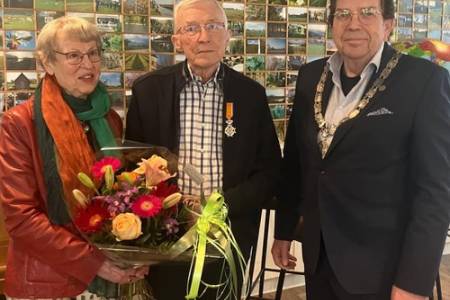 Several years ago Frans decided to write the course on sundials that included self assessment questions to force students not only to read the text, but to internalize the concepts. And a final submittal question "not necessarily a difficult question, but: no answer, no new lesson." Thus Frans Maes began writing lessons and sending them out to students.
NASS has now used his material to create...
Several years ago Frans decided to write the course on sundials that included self assessment questions to force students not only to read the text, but to internalize the concepts. And a final submittal question "not necessarily a difficult question, but: no answer, no new lesson." Thus Frans Maes began writing lessons and sending them out to students.
NASS has now used his material to create...
Pros and Cons of Daylight Savings Time
Monday, 24 March 2025 15:37
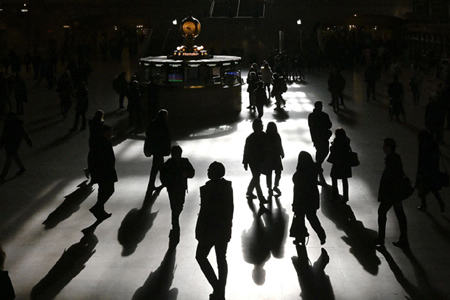 In a 24 March 2025 article from the on-line Science Advisor (American Association for the Advancement of Science) Phie Jacobs summarizes the "great debate" of the yearly shift from standard time to daylight savings time. In January 2025 the US Senate introduced the Sunshine Protection Act to permanently have daylight savings time year round. Certainly 54% of Americans do not like the...
In a 24 March 2025 article from the on-line Science Advisor (American Association for the Advancement of Science) Phie Jacobs summarizes the "great debate" of the yearly shift from standard time to daylight savings time. In January 2025 the US Senate introduced the Sunshine Protection Act to permanently have daylight savings time year round. Certainly 54% of Americans do not like the...
Native American Moon Alignment Ring
Friday, 21 March 2025 19:26
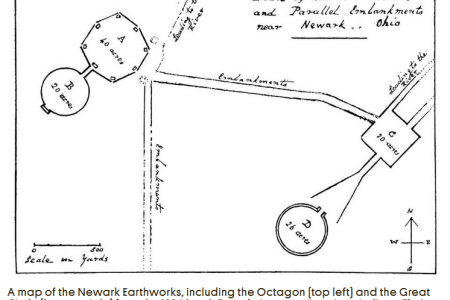 Perhaps the most famous alignment circle in the United States is the Cahokia Woodhenge near St. Louis constructed between 700-1400 CE by Cahokia Indigenous native Americans. But there were an estimated 10,000 other earthen mounds that once were scatter across the mid-west..
In an article from Atlas Obscura (https://www.atlasobscura.com/articles/octagon-earthworks-ohio) by Olivia Young on March...
Perhaps the most famous alignment circle in the United States is the Cahokia Woodhenge near St. Louis constructed between 700-1400 CE by Cahokia Indigenous native Americans. But there were an estimated 10,000 other earthen mounds that once were scatter across the mid-west..
In an article from Atlas Obscura (https://www.atlasobscura.com/articles/octagon-earthworks-ohio) by Olivia Young on March...
Hamilton Dial under Restoration
Friday, 21 March 2025 18:37
 The Hamilton dial is in the restorative care of Jarrett and Celene Hawkins (Hawkins & Hawkins Custom, LLC in Cincinnati Ohio https://www.studio-hawkins.com/) in preparation for the dial's dedication on Saturday, May 31, 2025.
The face of the Hamilton Grand Army of the Republic (GAR) sundial has been cleaned and bead-blasted showing the dial as it was cast 84 years ago. In the process,...
The Hamilton dial is in the restorative care of Jarrett and Celene Hawkins (Hawkins & Hawkins Custom, LLC in Cincinnati Ohio https://www.studio-hawkins.com/) in preparation for the dial's dedication on Saturday, May 31, 2025.
The face of the Hamilton Grand Army of the Republic (GAR) sundial has been cleaned and bead-blasted showing the dial as it was cast 84 years ago. In the process,...
VSSC Space Museum gets Polar Sundial
Tuesday, 17 December 2024 23:47
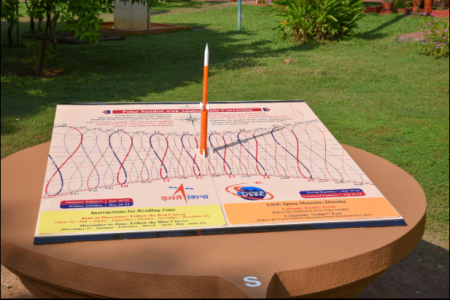 In November 2024, a team consisting of members from SPL, TTDG and CMD of VSSC successfully designed and installed an accurate and fully functional sundial at the Rocket Garden of VSSC Space Museum, Thumba (8.53°N, 76.86°E). Following a space theme, the vertical gnomon is a 3-stage rocket that casts its daily and seasonal shadow on a dial face 1 1/2 meters by 1 meter. The the sundial face...
In November 2024, a team consisting of members from SPL, TTDG and CMD of VSSC successfully designed and installed an accurate and fully functional sundial at the Rocket Garden of VSSC Space Museum, Thumba (8.53°N, 76.86°E). Following a space theme, the vertical gnomon is a 3-stage rocket that casts its daily and seasonal shadow on a dial face 1 1/2 meters by 1 meter. The the sundial face...
Historic Sundials of Andalusia
Saturday, 16 November 2024 00:07
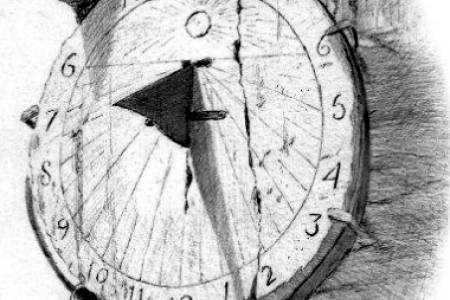 Esteban Martínez Almirón has published a new book Historical Sundials: Forgotten Andalusian Treasures (Relojes de Sol Históricos Tesoros Andaluces Olvidados) In it he reviews over 400 sundials from the Andalucian region of southern Spain Originally to celebrate the 25th year of the website https://relojandalusi.org/
Esteban Martínez Almirón began showing his sundial drawings on the site....
Esteban Martínez Almirón has published a new book Historical Sundials: Forgotten Andalusian Treasures (Relojes de Sol Históricos Tesoros Andaluces Olvidados) In it he reviews over 400 sundials from the Andalucian region of southern Spain Originally to celebrate the 25th year of the website https://relojandalusi.org/
Esteban Martínez Almirón began showing his sundial drawings on the site....
Hampton to Build 9/11 Memorial Sundial
- Details
- Hits: 12060
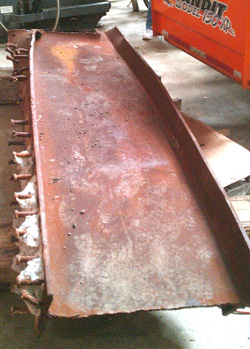 Todd Petty reported in the Hunterdon County Democrat that Tom Carpenter, a member of Fire Company 13 for forty-three years, presented plans to the city council for a 9/11 memorial in Veteran’s Park located in Hampton Borough, New Jersey.
Todd Petty reported in the Hunterdon County Democrat that Tom Carpenter, a member of Fire Company 13 for forty-three years, presented plans to the city council for a 9/11 memorial in Veteran’s Park located in Hampton Borough, New Jersey.
The park has memorials honoring local veterans from The Great War to those of the conflicts in Iraq and Afghanistan. During the twin tower collapse of 9/11 Tom Carpenter recalled, “Thank God we didn’t have anyone from Hampton Borough, but Lebanon and Bethlehem did. We did respond to Ground Zero within hours …and spent two days there. Hampton does have a direct connection [to 9/11] and we’re proud of it.”
September 11th Remembrance
- Details
- Hits: 14365
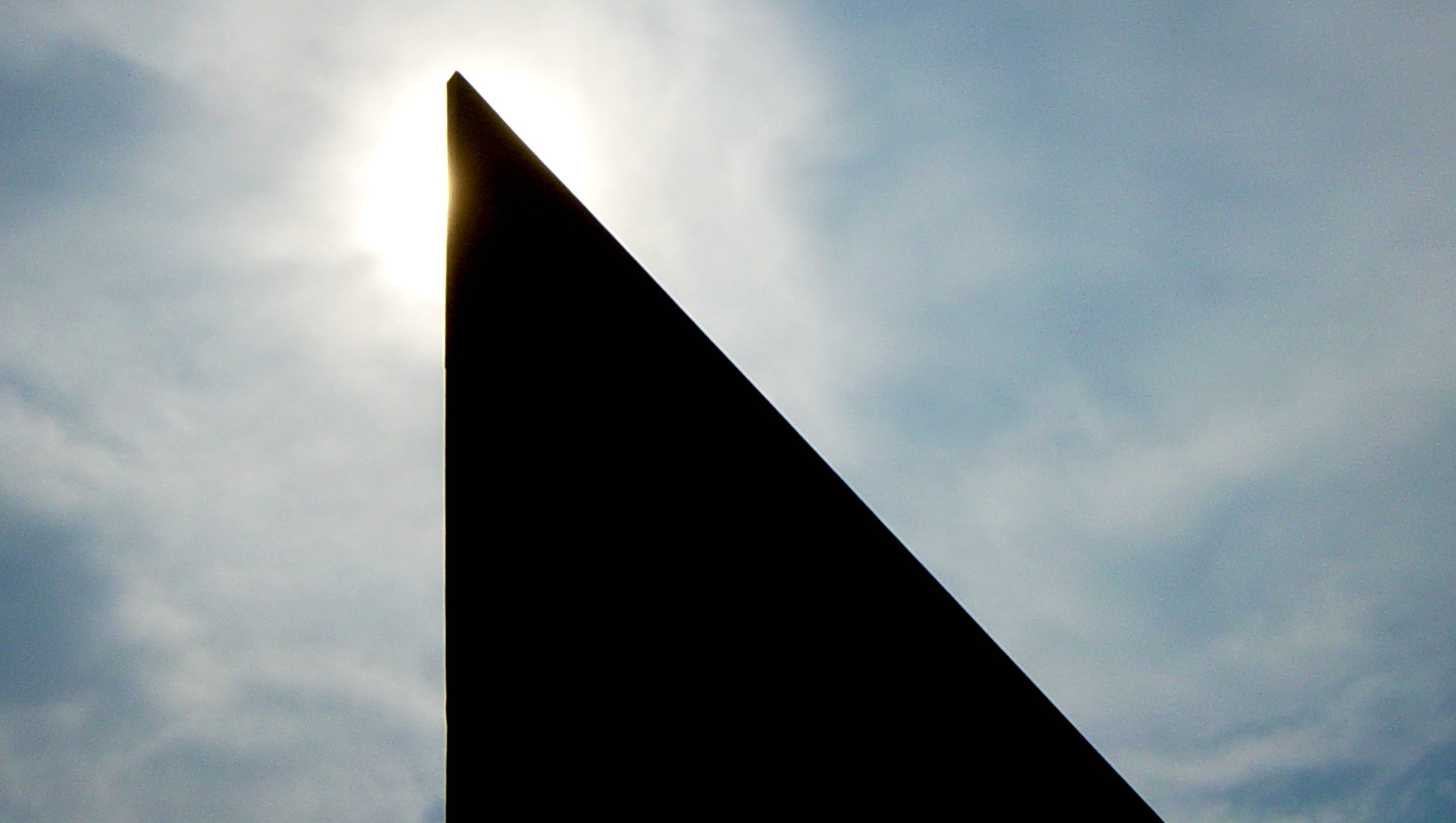 September 11th is a time of remembrance. At Freedom High School in Woodbridge, Virginia stands a large sundial dedicated in 2004 with four inlaid plaques. The plaques are arranged on the ground such that the gnomon shadow tip falls on them at 8:45, 9:03, 9:37 and 10:07 AM, the times of the four air crashes. Near the sundial is a low, black granite panel commemorating the citizens of Prince William County that lost their lives on September 11th, and the names of those citizen are on bricks surrounding the sundial.
September 11th is a time of remembrance. At Freedom High School in Woodbridge, Virginia stands a large sundial dedicated in 2004 with four inlaid plaques. The plaques are arranged on the ground such that the gnomon shadow tip falls on them at 8:45, 9:03, 9:37 and 10:07 AM, the times of the four air crashes. Near the sundial is a low, black granite panel commemorating the citizens of Prince William County that lost their lives on September 11th, and the names of those citizen are on bricks surrounding the sundial.
Two Worlds - One Beginning
- Details
- Hits: 8396
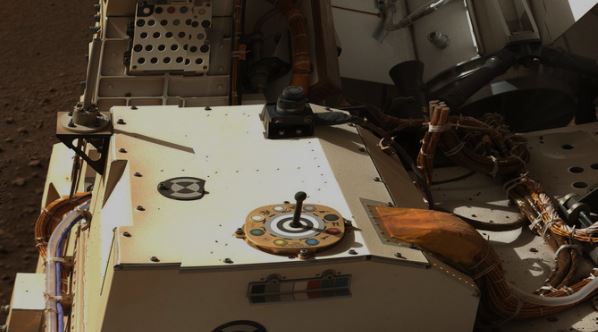 Everyone is excited about the landing of Perseverance, the Mars rover. If you look closely at the first panorama of the Martian landscape you will see on the equipment bay of Perseverance the Mastcam color calibration target. It sort of looks like it could be a sundial. In 2004 a similar calibration target was used as the first Martian sundial, designed by Dr. Woody Sullivan and Jim Bell with the support of The Planetary Society and Bill Nye, "The Science Guy" [See PDF at bottom]. Is the Mastcam color calibration target a sundial as well? Here is Dr. Sullivan's answer to a group of sundial enthusiasts (2/25/2021):
Everyone is excited about the landing of Perseverance, the Mars rover. If you look closely at the first panorama of the Martian landscape you will see on the equipment bay of Perseverance the Mastcam color calibration target. It sort of looks like it could be a sundial. In 2004 a similar calibration target was used as the first Martian sundial, designed by Dr. Woody Sullivan and Jim Bell with the support of The Planetary Society and Bill Nye, "The Science Guy" [See PDF at bottom]. Is the Mastcam color calibration target a sundial as well? Here is Dr. Sullivan's answer to a group of sundial enthusiasts (2/25/2021):
"The short answer is “No”. The longer answer follows. The new object on Perseverance (officially the "photometry calibration target") has obvious similarities to the Mars dials on Spirit and Opportunity that landed in 2004, and in fact it is a technological and aesthetic “grand-daughter” 17 years later. (The intervening generation is the Curiosity rover, which landed in 2013 and is still alive). The Mars dials that a small group of us designed and fabricated and then occasionally “used” to read Martian time were a great experience for me.
"But after over a decade of Spirit and Opportunity, I decided not to get involved in any future NASA missions — they gobble up a lot of time! The science and fabrication of the new calibration target (as for Curiosity) is led by a group at U. of Copenhagen.
"Nobody has ever done anything with the orientation of the shadows cast by the “gnomon” on Curiosity and I’m sure nobody will for Perseverance either. By the way, independent of gnomonics, the vertical tube has a vital scientific purpose: its shadow on the gray and colored patches allows one to calibrate camera images properly in shadow as well as sunlight.
"The various symbolism and messages on Perseverance also stem directly as heritage from Spirit and Opportunity . You can find a tremendous amount of detail about all aspects of the Perseverance cal target (including construction) at https://mastcamz.asu.edu/mars-in-full-color/ [See PDF at bottom]. The feature I like best is the motto “Two Worlds, One Beginning”, which nicely refers to Spirit and Opportunity ’s “Two Worlds, One Sun” as well as early solar system history and the possibility of early life on Mars. (Curiosity has the terrible motto “To Mars to Explore”.)
"Nevertheless, I watch the procession of missions with great astrobiology interest. And someday I will write up the whole Mars dial experience, including many Martian landscape images in which it appears, and how a student and I were actually able, using its shadow, to measure the Martian analemma at local mean (“clock”) noon over a Martian year ( = 1.9 Earth years).
— Woody Sullivan
Prof. (Emeritus) Woodruff T. Sullivan, III
Dept. of Astronomy & Astrobiology Program Box 351580
University of Washington
Seattle, WA 98195 USA
Planetary Society Brings Back Earth Dial
- Details
- Hits: 14340
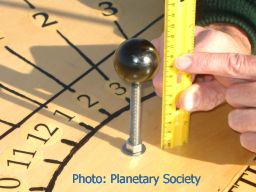 The Planetary Society and Bill Nye, The Science Guy, are bringing back the Earth Dial, which is a simple to make gnomonic horizontal sundial reminiscent of the sundial incorporated into the Mars rovers Spirit, Opportunity and now Curiosity. Their original and fundamental purpose is to serve as test patterns for the rover cameras, but they also provide an opportunity as unique shadow casting sundials.
The Planetary Society and Bill Nye, The Science Guy, are bringing back the Earth Dial, which is a simple to make gnomonic horizontal sundial reminiscent of the sundial incorporated into the Mars rovers Spirit, Opportunity and now Curiosity. Their original and fundamental purpose is to serve as test patterns for the rover cameras, but they also provide an opportunity as unique shadow casting sundials.
“Since we had shadows being cast on Mars, I suggested it be a sundial… I admit I was quite enthusiastic about it. Steve Squyres, the Principle Investigator on the Spirit and Opportunity missions, made the call, and the Mars Dials were created. He received the [Planetary] Society’s Cosmos medal a few years ago, for his wonderful leadership of the project.”
The Earth Dial project was started in 2004 and now, nearly a decade later, is being brought back. Visit the Planetary Society website Planetary Society - Earth Dial for details and download the attachment below to construct your own Earth Dial.
TED Lecture - Sundials to Mars
- Details
- Hits: 16892
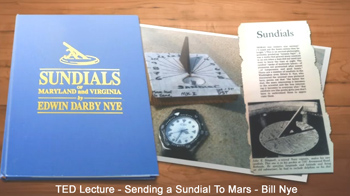 Bill Nye, The Science Guy gives a 7 minute TED-ED talk describing the excitement of creating sundials on Mars. http://ed.ted.com/lessons/sending-a-sundial-to-mars-bill-nye
Bill Nye, The Science Guy gives a 7 minute TED-ED talk describing the excitement of creating sundials on Mars. http://ed.ted.com/lessons/sending-a-sundial-to-mars-bill-nye
TED stands for Technology, Entertainment, and Design, a nonprofit organization devoted to spreading ideas of worth. Conferences are held each year with more than 50 guest speakers to motivate the audience on many different fields and now through YouTube, you can share the excitement of sundialing.
Curiosity Carries Sundial
- Details
- Hits: 15447
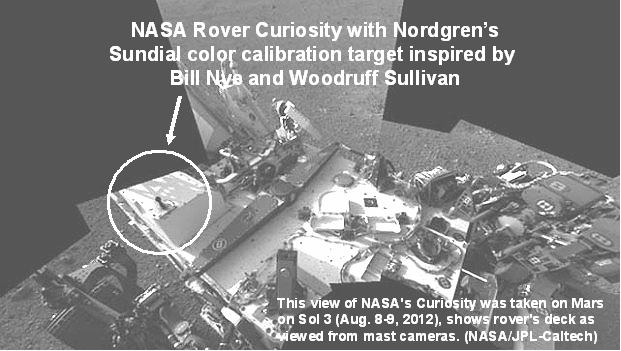 With the successful landing of the NASA rover Curiosity, another sundial is on planet Mars. Turning the color calibration target into a sundial was the idea of Bill Nye, the Science Guy, and Professor Woodruff Sullivan at the University of Washington, originally hailed by “Two Worlds – One Sun”
With the successful landing of the NASA rover Curiosity, another sundial is on planet Mars. Turning the color calibration target into a sundial was the idea of Bill Nye, the Science Guy, and Professor Woodruff Sullivan at the University of Washington, originally hailed by “Two Worlds – One Sun”
THese two sundial enthusiasits have been encouraging people around the world to make their own sundials and collectively participate using webcams to tell solar time around the earth. See: http://sundials.org/index.php/features/168-curiosity-sundial-launched and read the details of the sundial with the following PDF download: MarsDialReport.pdf
Curiosity’s calibration target was created by Tyler Nordgren at the University of Redlands. However Nordgren and a group of six scientists, astronomers, educators, and artists (including Nye and Sullivan) went further. Said Nordgren, "But we thought, why not use this very dry boring technical piece of equipment, and turn it into something beautiful and evocative?"
The calibration target turned sundial is actually a leftover from NASA’s Mars Exploration Rover (MER) Spirit. Along the edges of the sundial MARS is written out in 16 different languages. The sundial’s center represents the sun with a concentric grey ring for the earth’s nearly circular orbit and a displaced white ring for Mars eccentric orbit. The positions of Earth and Mars, shown respectively by a blue and red dot are placed for the date of impact at 10:32 pm Aug 5th PDT. Every MARS sundial has a date and motto. “It's sundial tradition,” says Nordgren. Curiosity says "MARS 2012" and "TO MARS TO EXPLORE."
Each home-plate color slice has a phrase describing what the mission means for human exploration. It reads:
“For millennia, Mars has stimulated our imaginations. First we saw Mars as a wandering red star, a bringer of war from the abode of the gods. In recent centuries, the planet's changing appearance in telescopes caused us to think that Mars had a climate like the Earth's. Our first space age views revealed only a cratered, Moon-like world, but later missions showed that Mars once had abundant liquid water. Through it all, we have wondered: Has there been life on Mars? To those taking the next steps to find out, we wish a safe journey and the joy of discovery."
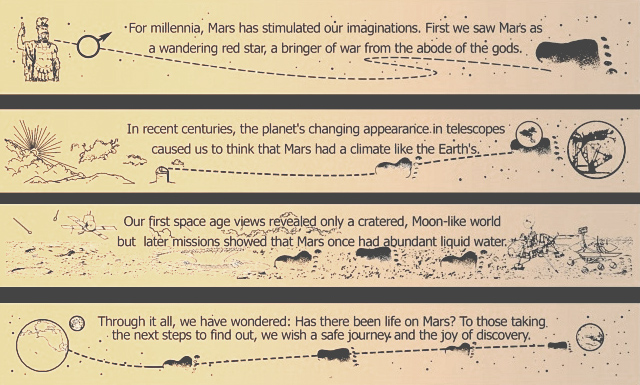
Dr. Woody Sullivan discussed the history of the Mars Dials on a recent Sundial Digest forum (11 Aug 2012, Vol. 80, Issue 8) https://lists.uni-koeln.de/mailman/listinfo/sundial
“[Above] is the first image of the latest "Mars Dial", which indeed is the calibration device for the main camera ("Mastcam") on Curiosity Rover, which landed safely in Gale Crater on Mars 5 days ago (hurrah!)."
"The Mars Dials were originally fabricated in 1999 for the Mars Rovers Spirit and Opportunity, which landed in 2004, and the latter of which is STILL working over 8 years later. To date over 35,000 images have been taken of the two Mars Dials - the most photographed thing on Mars! As mentioned below, I was intimately involved in all aspects of making these calibration devices into working sundials - design, fabrication, operations, etc. However, because of other commitments I chose not to be part of any Curiosity efforts, so my report in the following paragraph is that of a (very) interested observer."
"In order to save some money, the Curiosity Mars Dial is a slight modification of one of the 6 copies that we made in 1999. A couple of magnets were added (to try to repel dust), new plates were put on it to change various wording such as the date and, in particular, the motto. The motto is now "To Mars To Explore" rather than the previous "Two Worlds One Sun". But the biggest difference is that, as far as I know, no one is ever going to superimpose the hour/date lines so that it can actually be used as a sundial! And yet NASA's publicity continues to call it a sundial.....But I'm still very happy to see the first images of it….”
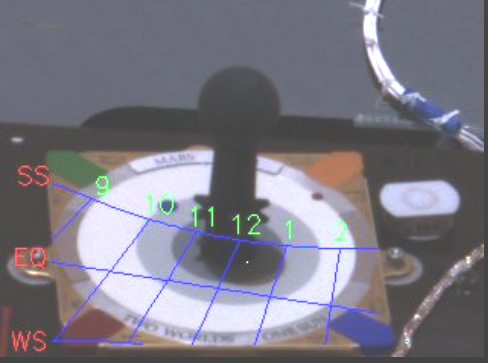
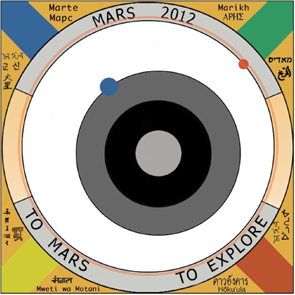 The image here is from the Mars Exploration Rover Spirit (look carefully for the motto “Two Worlds One Sun”) and according to a NASA news release, “was processed by students in the Red Rover Goes to Mars program to impose hour markings on the face of the dial. The position of the shadow of the sundial's post within the markings indicates the time of day and the season, which in this image is 12:17 p.m. local solar time, late summer. A team of 16 students from 12 countries were selected by the Planetary Society to participate in this program. This image was taken on Mars by the rover's panoramic camera.” [Image was produced at Cornell University - Image Nr: PIA05017]
The image here is from the Mars Exploration Rover Spirit (look carefully for the motto “Two Worlds One Sun”) and according to a NASA news release, “was processed by students in the Red Rover Goes to Mars program to impose hour markings on the face of the dial. The position of the shadow of the sundial's post within the markings indicates the time of day and the season, which in this image is 12:17 p.m. local solar time, late summer. A team of 16 students from 12 countries were selected by the Planetary Society to participate in this program. This image was taken on Mars by the rover's panoramic camera.” [Image was produced at Cornell University - Image Nr: PIA05017]
For more details of the Curiosity sundial, read an interview with Tyler Nordgren: http://www.popsci.com/science/article/2012-08/mars-rover-curiosity and http://wtvr.com/2012/08/03/nasa-mars-rover-curiosity-will-land-early-monday/
Read more about Curiosity’s instruments at http://www.nasa.gov/mission_pages/mars/main/index.html
Curiosity Sundial Launched
- Details
- Hits: 14855
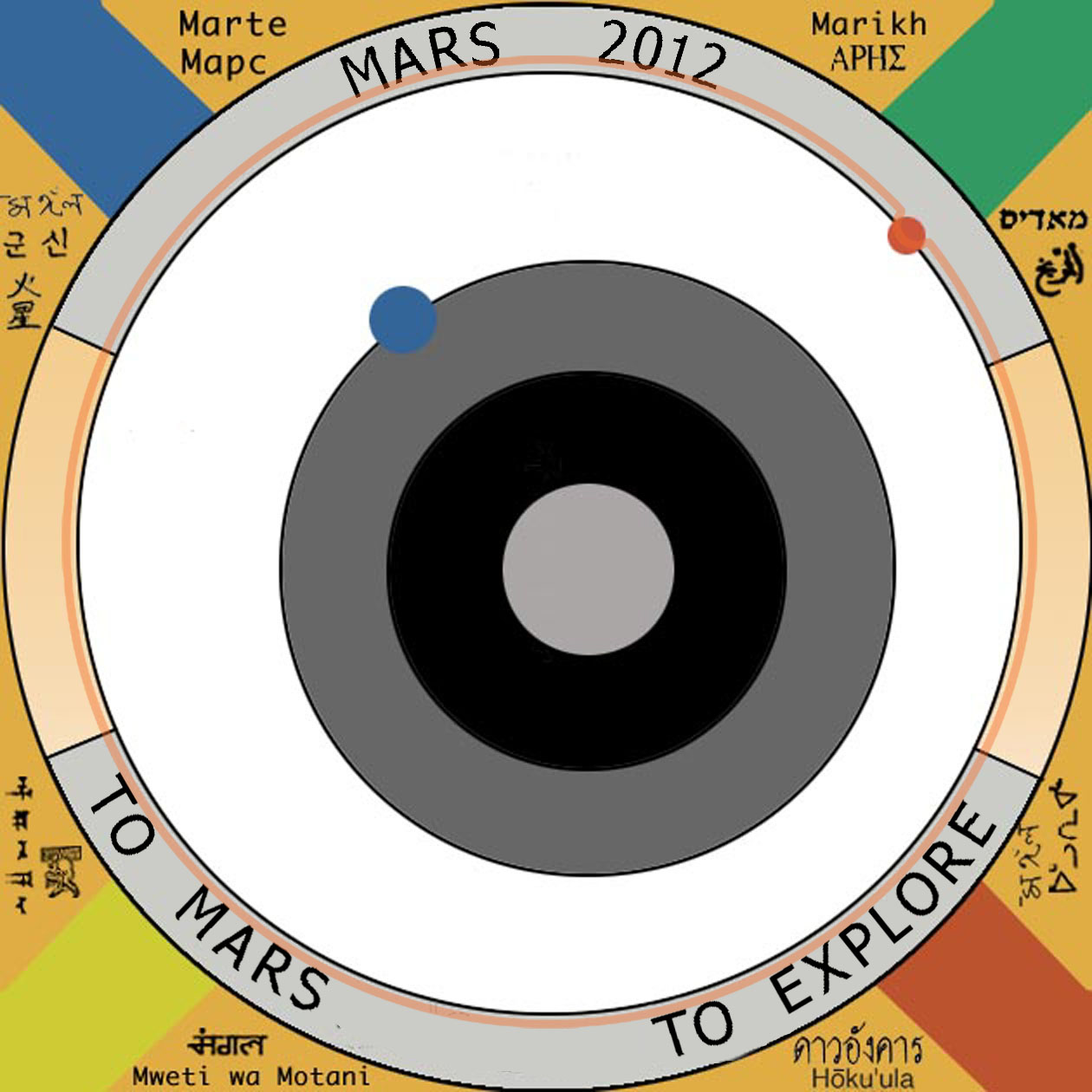 [photo courtesy of NASA]
|
The spacecraft was launched toward Mars on 26 Nov 2011. Onboard Curiosity the camera calibration sundial has four edges each containing a panel of text and image, written by Jim Bell, planetary scientist from Arizona State University and the Mars Exploration Rover team with graphics designed by artist Jon Lomberg.
The digital camera and calibration target was created by Tyler Nordgren from the University of Redlands and a group of six scientists, astronomers, educators and artists worked together to create a digital camera that is calibrated to photograph the climate on Mars. On the team was Bill Nye and Professor Sullivan.
Dr. Bell now executive Director of the Planetary Society and Lomberg were both on the team that designed the similar sundials for the the Spirit and Opportunity Martian rovers. Artist Jon Lomberg has a long history in spacecraft graphics, starting with Design Director for NASA’s Voyager Golden Record and a long-time collaborator of Carl Sagan. He won an Emmy Award for his work as Chief Artist of the TV series COSMOS. Read more at http://www.redlandsdailyfacts.com/news/ci_19476230 and http://citizenofthegalaxy.com/wordpress/?p=169
ENEA Solar Compass Soon to be Smartphone App
- Details
- Hits: 12312
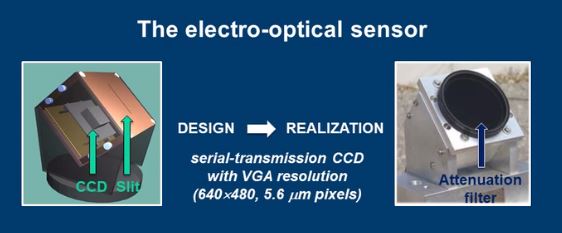 The National Agency for New Technologies, Energy and Sustainable Economic Development (ENEA) is an Italian Government sponsored research and development agency. In 2017 Sara Bollanti and her team at ENEA in Frascati developed a solar compass that "is 100 times more precise than magnetic compasses..." with applications for surveying, civil engineering, and for us, sundial alignment. The heart of the device is a combination of GPS receiver for determining both time and geographic position and a solar collector consisting of a narrow slit and a CMOS image detector. Essentially this is an electronic solar azimuth compass. A smallArduino computer uses the UTC time plus geographic coordinates to compute the local sun azimuth and then compares it to the position of the sun's projection of a slit on a CMOS detector. According to ENEA, the "...electronic solar compass is compact, completely automatic, cheap, and reaches an accuracy better than 1 arcmin. The latter is one of the best currently available values, comparable to those achievable by means of much more expensive and sophisticated devices, like coupled GPS systems (see for example U.S. patent 5,617,317A, 1997) or gyrocompasses. Furthermore, the ENEA compass provides the orientation in a few seconds, a time extremely shorter than that necessary for gyrocompasses."
The National Agency for New Technologies, Energy and Sustainable Economic Development (ENEA) is an Italian Government sponsored research and development agency. In 2017 Sara Bollanti and her team at ENEA in Frascati developed a solar compass that "is 100 times more precise than magnetic compasses..." with applications for surveying, civil engineering, and for us, sundial alignment. The heart of the device is a combination of GPS receiver for determining both time and geographic position and a solar collector consisting of a narrow slit and a CMOS image detector. Essentially this is an electronic solar azimuth compass. A smallArduino computer uses the UTC time plus geographic coordinates to compute the local sun azimuth and then compares it to the position of the sun's projection of a slit on a CMOS detector. According to ENEA, the "...electronic solar compass is compact, completely automatic, cheap, and reaches an accuracy better than 1 arcmin. The latter is one of the best currently available values, comparable to those achievable by means of much more expensive and sophisticated devices, like coupled GPS systems (see for example U.S. patent 5,617,317A, 1997) or gyrocompasses. Furthermore, the ENEA compass provides the orientation in a few seconds, a time extremely shorter than that necessary for gyrocompasses."
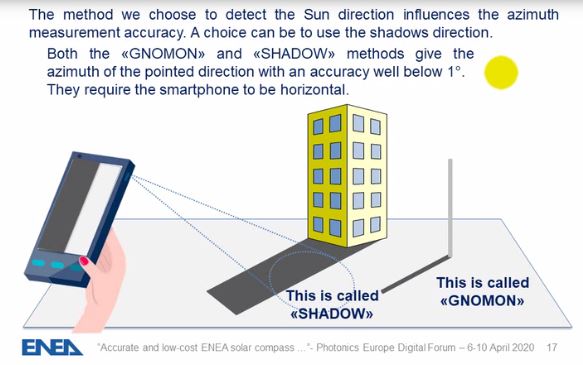 By 2018 this was tested in Antarctica and now the mathematics has been reduced to fit into your smart phone. In April 2020 the ENEA team announced the developed the smartphone app i called "SunPass". It is currently in beta testing and will soon be available at the Play Store. In basic form, the app allows you to acquire the sun azimuth by pointing toward the shadow of a vertical object such as a building ("shadow method") or the shadow of a vertical pole ("gnomon method"). A more accurate appraoch is to construct a box with a slit on the front and hole on top such that the smartphone can observe the illuminated sun line on the floor of the box ("Slit method"). For the advanced, one can construct a precision holder from a kit that mounts on a tripod.
By 2018 this was tested in Antarctica and now the mathematics has been reduced to fit into your smart phone. In April 2020 the ENEA team announced the developed the smartphone app i called "SunPass". It is currently in beta testing and will soon be available at the Play Store. In basic form, the app allows you to acquire the sun azimuth by pointing toward the shadow of a vertical object such as a building ("shadow method") or the shadow of a vertical pole ("gnomon method"). A more accurate appraoch is to construct a box with a slit on the front and hole on top such that the smartphone can observe the illuminated sun line on the floor of the box ("Slit method"). For the advanced, one can construct a precision holder from a kit that mounts on a tripod.
ENEA's goal of a low cost, simple method of precision alignment is now accessible to all. This new technology implements the mathematics of determining the sun's azimuth in elegant ways. But of course it only works on sunny days.
Read more at:
http://eai.enea.it/archivio/anno-2017/astana-italy/the-enea-solar-compass-how-to-catch-more-sun-by-using-the-sun
And watch the video:
https://www.spiedigitallibrary.org/conference-proceedings-of-spie/11352/1135216/Accurate-and-low-cost-ENEA-solar-compass-for-precision-metrology/10.1117/12.2555747.full?SSO=1
Daku's Shadow Writing
- Details
- Hits: 12792
Whether it be Delhi or Las Vegas, artist Daku brings shadows to life, creating words that slowing change their shape but never lose their meaning through the course of the day. As reported by mymodernmet.com, "As part of the St.Art festival, which curates public art in Delhi’s Lodhi district, Daku’s carefully realized [shadow] installation demonstrates the power of words. The artist, whose name means 'bandit' in Hindi, had been thinking about executing this project for several years when finally given the opportunity by the festival." The anonymous artist Daku told CNN, “I had to decide the size of the letters, the length of the pieces, and the angle I could place them in so pedestrians could easily see it.” mymodernmet.com concluded "The artist carefully selected which words to include—balance, order, reflection, future, seasons, space—each a reflection on movement, time, and change. Reaching its apex at mid-day, the letters slowly blur and dissolve, put to rest each evening before beginning anew."

The making of shadow writing in Las Vegas by Daku
Daku's cut-out words on the south facing walls of buildings is a clever implementation of sundial and involves a lot of subtle mathematics. Daku's lettering is placed on the wall horizontal to the ground, usually with very little change in the scale of the lettering. Mathematically the noonday lettering on the wall is lengthened by the tangent of the latitude plus solar declination. But the visible size of the lettering is foreshortened by the cosine of the upward look angle of the pedestrian on the ground.
Read more at: Daku's installation in Las Vegas and Daku's installation in Delhi
Site Search
Sundial Question?
Current Sun
Civil = Sundial + EoT + dLon
where dLon is (4xNr Degrees W. of Time Zone
Select Sundials by State/Province
Who's Online
We have 885 guests and no members online
